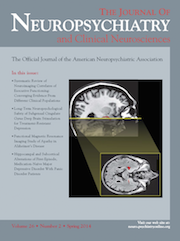Blonanserin Improved Dystonia Induced by Risperidone or Olanzapine in Two Patients With Schizophrenia
To the Editor: Blonanserin has strong dopamine 2 (D2) receptor, 5-hydroxytryptamine (5-HT)-2A receptor, D3 receptor blocking activity and weak 5HT-2C, D1, and α1 receptor blocking activities while being almost devoid of histamine H1 and muscarinic M1 blocking activity.1,2 Discontinuation of BNS for intolerability was the least frequent among atypical psychotics.3 We present two cases in which dystonia induced by risperidone or olanzapine was improved after switching to blonanserin.
CASE REPORTS
Case #1:
A 25-year-old woman started to experience auditory hallucinations, thought insertion, and delusion of being observed. At 26 years old, she was prescribed 5 mg/day of risperidone. Her psychotic symptoms diminished, but she had tongue dystonia once or twice a week. She took 1 mg/day of biperiden, but her dystonia did not diminish. Every time she stopped taking risperidone, her psychotic symptoms recurred. At 30 years old, she relapsed because of the discontinuation of risperidone and was hospitalized. After we switched her to 20 mg/day of blonanserin, her psychotic symptoms diminished and she was discharged. She has not experienced tongue dystonia.
Case #2:
A 20-year-old woman started to experience a delusion of being pursued, thought insertion, and a delusion of persecution. She was violent toward her mother and sister. At age 22, she was prescribed 2 mg/day of risperidone. Her psychotic symptoms diminished, but her menstrual cycle became irregular and she discontinued treatment with risperidone. At 26 years old, her psychotic symptoms worsened again, and she was hospitalized. She took 20 mg/day of olanzapine for 2 weeks, and her psychotic symptoms decreased. However, she experienced eye dystonia once or twice a week. She was given 4 mg/day of trihexyphenidyl hydrochloride, and we decreased the dose of olanzapine to 12.5 mg/day. However, her dystonia did not diminish. After we switched her to 16 mg/day of blonanserin, her dystonia and psychotic symptoms decreased and she was discharged. Trihexyphenidyl hydrochloride was reduced to 2 mg/day.
The dose of antipsychotics and the degrees of D2, 5-HT-2A, and M1 receptor occupation are well known to be related to the occurrence of dystonia. In case 1, the dose of 20 mg/day of blonanserin is equal to 5 mg of risperidone (blonanserin: risperidone=4: 1).2 In case 2, the dose of 12.5 mg/day of olanzapine is slightly more than 16 mg/day of blonanserin (blonanserin: olanzapine=4: 2.5).3 This is one reason for the disappearance of dystonia, but the patient’s psychotic symptoms did not allow the reduction of olanzapine.3 Risperidone and olanzapine are thought to be superior to blonanserin because blonanserin has stronger affinity to D2 receptors than to 5-HT-2A receptors. On the point of M1 antagonism, olanzapine is supposed to be superior to blonanserin and risperidone. Though risperidone and olanzapine are supposed to be superior to blonanserin, a clinical study showed that blonanserin has as much risk of causing dystonia as the risk associated with risperidone.2 Because a high degree of D3 receptor blockade is reported to be predictive of a low risk of extrapyramidal syndrome,5 the dystonia diminished after switching to blonanserin may be the D3 receptor-binding affinity.
1 : Blonanserin: a review of its use in the management of schizophrenia. CNS Drugs 2010; 24:65–84Crossref, Medline, Google Scholar
2 : Efficacy and tolerability of Blonanserin in the patients with schizophrenia: a randomized, double-blind, risperidone-compared trial. Clin Neuropharmacol 2010; 33:169–175Crossref, Medline, Google Scholar
3 : Efficacy and tolerability of blonanserin in 48 patients with intractable schizophrenia. Acta Neuropsychiatr 2012; 24:380–383Crossref, Medline, Google Scholar
4 :
5 : Dopamine D3 receptor antagonists as therapeutic agents. Drug Discov Today 2005; 10:917–925Crossref, Medline, Google Scholar



